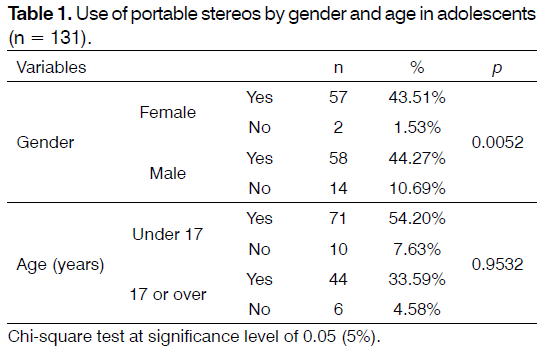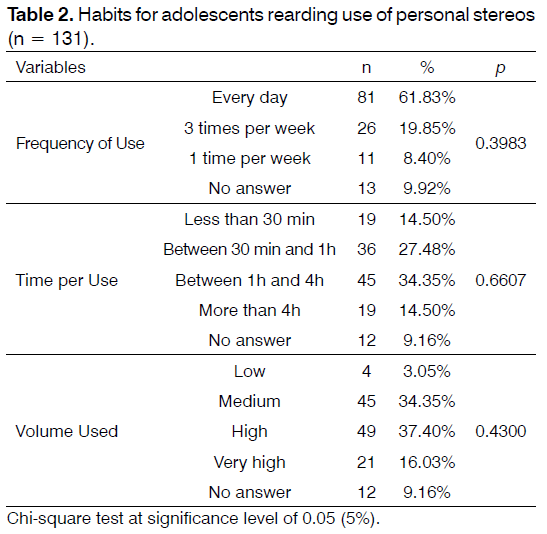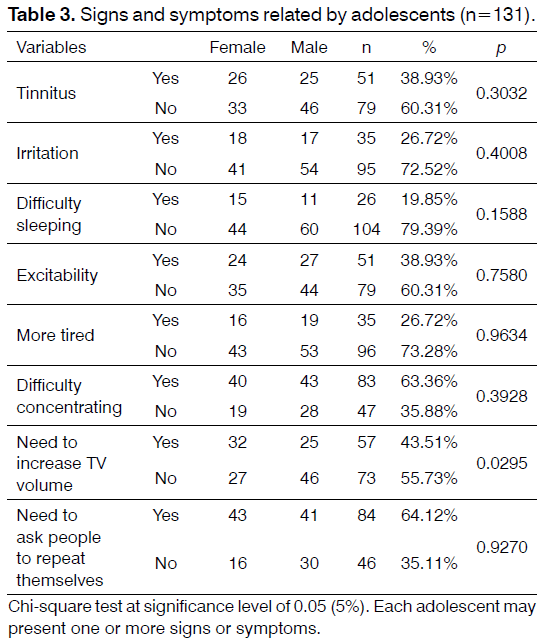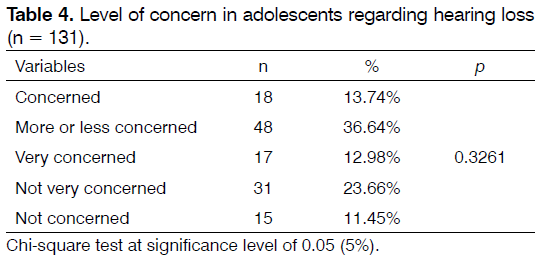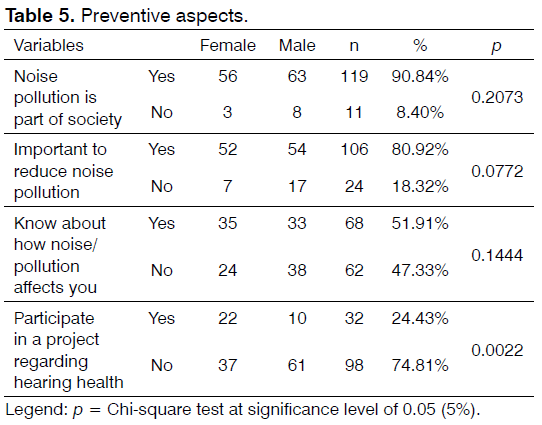The International Tinnitus Journal
Official Journal of the Neurootological and Equilibriometric Society
Official Journal of the Brazil Federal District Otorhinolaryngologist Society
ISSN: 0946-5448

Google scholar citation report
Citations : 12717
The International Tinnitus Journal received 12717 citations as per google scholar report
The International Tinnitus Journal peer review process verified at publons
Indexed In
- Excerpta Medica
- Scimago
- SCOPUS
- Publons
- EMBASE
- Google Scholar
- Euro Pub
- CAS Source Index (CASSI)
- Index Medicus
- Medline
- PubMed
- UGC
- EBSCO
Volume 20, Issue 1 / June 2016
Research Article Pages:42-47
10.5935/0946-5448.20160008
Amplified music with headphones and its implications on hearing health in teens
Authors: Sarah Herrera; Adriana Bender Moreira de Lacerda; Debora Lurdes; Fernanda Rocha; Patricia Arruda Alcaras; Lucia Helena Ribeiro
PDF
Abstract
Objectives: To analyze the habits and behavior of adolescents exposed to amplified music with headphones and its implications on their hearing health.
Methods: One hundred thirty-one high school students, aged 15 to 18 years were given a questionnaire containing closed questions regarding their habits and behavior related to personal stereos use. It is a descriptive cross-sectional study and used the Chi-square test.
Results: It was shown that 79% of young people make use of portable music devices, 61.83% have a habit of using them often, 34.35% have long periods of exposure, and 37.40% use them at high volume. In terms of symptoms, present were: difficulty concentrating 63.36%; the need to ask people to repeat what was said 64.12%; the need to increase the TV volume 43.51%; tinnitus 38.93%, excitability 38.93%; and 36.64% of teens say they are somewhat worried about losing their hearing through the use of personal stereos. For the preventive aspects, 90.84% believe that noise is part of society, 80.92% find it important to reduce noise pollution, 51.91% would like to know the influence of the noise/pollution, but 74.81% would not like to participate in projects with questions about hearing health.
Conclusion: The youths in this study are making indiscriminate use of personal stereos with headphones, within a population at risk for hearing loss considering its habits. Hearing Health Promotion Programs are recommended for this population.
Keywords: tinnitus, hearing, hearing loss, noise-induced, health risk.
Introduction
Today, with technological advances, it is easy to find children, youths and adults using electronic devices with earphones, due to the convenience of listening to music anytime and anywhere. However, not everyone knows that excessive use of these devices may cause irreversible damage to hearing [1], in the short or long term [2].
This habit, when frequent, added to the exposure time, the physical characteristics (such as frequency and intensity), and other non-occupational noise at high sound levels, determines the impact on hearing health, and results in a public health problem, which affects most of the world population [1-4].
Hearing loss induced by music or by high sound pressure levels (HSPLIHL) has similar characteristics to hearing loss caused by occupational exposure to noise, with slow onset, progressive, irreversible, sensorineural, bilateral hearing loss that initially affects high frequencies and then the other frequencies [2]. Such a loss can develop into a major public health and social problem since a growing number of adolescents and adults have symptoms related to exposure, such as distortion, intolerance to loud sounds, dizziness, earache, difficulty understanding or hearing words, tinnitus, and alterations in auditive thresholds [5,6]. The problem can also cause extra-auditive damage, such as sleep disorders, cardiovascular disorders, stress, fatigue, tension, irritability, inattention, tiredness, nervousness, headache, and arterial hypertension [7,8]. According to the American Speech Language Hearing Association (ASHA), 61% of American teenagers have personal stereos [9,10], while 51% of students in American high schools have symptoms of hearing loss. An interesting part of that study was the fact that most students prefer high volumes, as adults tend to use more moderate volumes. In the Netherlands, another study showed similar results, especially in adolescent men [6].
According to the World Health Organization (WHO), about 1.1 billion young people worldwide are at risk of hearing loss due to exposure caused by unsafe use of personal audio devices. Almost half of all adolescents and young adults (12-35 years old) in average and high income countries, are exposed to unsafe levels of sound from the use of personal audio devices, and about 40% of them are exposed to potentially harmful noise levels in clubs, discos and bars [11].
In a study [12] made with 125 adolescent students of primary and secondary schools from various municipal districts, of both genders, with a mean age of 16.7 years, it was found that listening to music while wearing a headset is the most frequent habit reported by young people.
Research in the USA has shown that young people are losing hearing sharply due to habitual use of personal stereos at high volumes. Some manufacturers already use a mechanism that warns the user if they exceed the exposure limit. This technique, which works in function of the volume versus the amount of time used, employs audible beeps at frequencies that can be heard over the music. The user hears the beep, which hinders the appreciation of music and after a reduction in volume, the whistle stops [13].
Among the problems caused by the misuse of headsets are tinnitus, dizziness, difficulty understanding speech, and decreased ability to hear. Difficulty and hearing loss occur in subtle ways so that people do not detect them in time to remedy the problems, and when they finally notice, the lesions are irreversible. This leads to certain sensory difficulties that can directly affect the health and quality of life of people [14].
A study of 400 students of both sexes, between 14 and 30 years old, who reported the habit of using personal stereos, concluded that the auditory symptoms most prevalent in users were discomfort to loud sounds, difficulty perceiving sounds, difficulty understanding speech in noisy environments, ear fullness, tinnitus, ear pain and hearing loss. In the same study, it was observed that, despite admitting being aware of the damage that intense sound exposure can cause to hearing, the daily habits of young people show the inappropriate use of portable stereos characterized by long periods of exposure, high volume intensities, frequent use, and preference for insert-style earphones. The high prevalence of symptoms after use suggests a higher risk to hearing for these youths [15].
One study [12] showed that 38.4% of participants reported temporary tinnitus and sensitivity to noise. However, only 8.8% are concerned about going to shows, nightclubs or other noisy places due to previous experiences of tinnitus.
Thus, to act in a more objective way and direct orientation, awareness, and prevention of hearing loss induced by high sound pressure levels (HSPLIHL) in young people, hearing health promotion programs are highly recommended. Guidance actions for hearing preservation can avoid noise induced losses, promoting better hearing health through educational strategies, changing lifestyles, work, and behavioral factors [12,16-23].
This study aimed to know more about the habits and behaviors of southern Brazilian adolescents for exposure to music while wearing headphones, and its implications on hearing health, in order to implement preventive measures related to music induced hearing loss.
Materials and Methods
This is a descriptive transverse cohort study, developed at high schools, both located in in the state of Paraná, Brazil, and was approved by the Research Ethics Committee at the Hospital das Clínicas, Federal University of Paraná, CAAE under number 0214.0.208.000-11 and recorded in CEP: 2576.183/2011-8.
The sample consisted of 131 young people of both sexes between the ages of 15 and 18, and all participants included in the study signed a consent form that assured the participant’s anonymity.
The students were asked to answer a questionnaire with closed questions developed by the authors, with questions related to hearing history as well as information on habits and behavior related to amplified music with headphones. Young people individually answered questions in their own classrooms.
The data were analyzed in order to obtain the characteristics of participants (gender, age, time of use of personal stereos and others), their knowledge of risks to hearing health, and behavior against these risks. Statistical analysis was performed using the Chi-square test with significance level at 0.05 (5%), excluding unanswered questions from the sample.
Results
Of the 131 young people in the sample, from 15 to 18 years of age, 45.04% were female and 54.96% male.
Table 1 shows the results for the use of portable devices. There was a significant correlation found (p = 0.0052) between gender and use of portable devices (the male audience used them more), and there was no significant correlation (p = 0.9532) between age and use of portable devices.
Table 2 shows the results regarding the daily habits of exposure to electronically amplified music with headphones. As to the frequency of use, it was observed that 61.83% of the participants have everyday use, 19.85% use the devices three times a week, and 8.40% makes use of them once a week.
With regard to the volume range used, 37.40% of the subjects listen to music at a loud volume, 34.35% at a medium volume, 16.03% at a very high volume, and only 3.05% at low volume.
It was also found that 34.35% of the young people often listen to music for a period ranging from one to four hours per day.
Regarding the presence of symptoms in relation to possible risks after exposure to the use of personal stereos (Table 3), difficulty concentrating and the need to request people to repeat themselves presented above a 50% response, followed by the need to increase TV volume, tinnitus and excitability. It was also found that there is significant correlation (p = 0.0295) between gender and the need to increase the TV volume, in which the female audience surveyed higher.
With regard to concern about hearing loss via the use of personal stereos (Table 4), 13.74% said they were concerned, 36.64% were more or less concerned, 12.98% very concerned, 23.66% are not very concerned, and only 11.45% say they are not concerned at all.
Regarding preventive aspects (Table 5), it was found that 90.84% of respondents think that noise is part of our society, 80.92% find it important to reduce noise pollution, 51.91% would like to know how noise/ noise pollution affects their lives, and 74.81% would not like to participate in projects related to the topic of hearing health. Through analysis of the Chi-square test, at a significance level of 0.05, it was found that there is a significant correlation (p = 0.0022) between gender and participation in a hearing health project, in which the female audience showed greater interest in participating in hearing health projects.
Discussion
The survey was conducted with 131 young people, between 15 and 18 years old. Participants were of both sexes (female: 45.04% and male: 54.96%).
After analyzing the results, it can be observed that youngest people, 79%, make use of portable devices, with a significant difference between genders, having a more significant result in males (Table 1). This result is similar to retrospective studies [24,25], which found the presence of this habit in youngest men.
Regarding usage habits related to the use of personal stereos (Table 2), 61.83% of participants in this study have the habit of frequently using personal stereos, using them every day, 34.35% use them for long periods, ranging from one to four hours per day, and 37.40% listen at high volume. These findings corroborate other studies with this population [15,26-28].
Studies have shown in using headphones, a period of two hours is sufficient for subsequent hearing impairment hearing. It was also found that listening to loud music directly into the ear can damage the sensitive hair cells in the inner ear [2-4,6,28-30].
Faria and Mello [26] said that the inappropriate use of individual devices, such as MP3 players, Discman, Walkman, and others, for a long time and at high volume is a major cause of hearing loss in young people.
In one study [13] with 30 subjects and aiming to investigate whether there is damage and the extent of damage due to MP3 players, it was found that people exposed to loud noise show significant reduction in the amplitude of otoacoustic emissions, indicating temporary alterations to cells for the cochlea - damage which may become permanent if the exposure is continuous.
According to the European Agency for Safety and Health at Work [31], individuals who have the habit of using personal devices for at least four hours a week are subject to greater risk of developing hearing loss.
Regarding signs and symptoms (Table 3) related to hearing, the students from this study cited eight symptoms. The most common were difficulty concentrating and the need to ask people to repeat themselves, followed by the need to increase TV volume, tinnitus, and excitability.
The results for hearing symptoms obtained in this study were similar to those reported in other studies [10,16,25,32-34]. Authors found complaints such as tinnitus, ear fullness, insomnia, and headache as well as other symptoms, not just hearing-related symptoms.
In another study [15], the auditory symptoms most mentioned by personal stereo users were ear fullness, followed by tinnitus. It is believed that tinnitus, the feeling of a blocked ear, and decreased hearing after excessive exposure to amplified music may be the first signs of music induced hearing loss. In this study, it was shown that the longer exposure time, the higher the prevalence of tinnitus.
In another study [28], in addition to tinnitus, changes were observed in thyroid hormones only in individuals who were personal stereo users.
In the case of non-hearing damage, it is known that noise, or any other stressor, may cause various physiological, behavioral, and physiological changes in an individual. One study [35] reported that individuals exposed to high sound pressure levels are affected mentally and physically. Furthermore, they have numerous other symptoms, specifically highlighting: insomnia, neurological disorders, vestibular disorders, vascular disorders, behavioral disorders, increased blood pressure, gastrointestinal disturbances, irritability, and communication difficulties [15,34].
Another study [36] conducted with subjects who use personal stereos for more than an hour a day, reported that they perceived a lack of concentration and a change in behavior.
A different study [37] reported that those who use listen to music at high volumes while wearing headphones had alterations in attention and concentration, as well as another little-known problem - the formation of dermatitis and eczema on the ears. The researchers advised constant care, not only related to volume levels, but also the cleaning of the earphones.
In another study [9] done with high school students, the author stated that such individuals are more likely to report complaints related to hearing than adults. Most teens answered in the affirmative regarding the following complaints: increase the volume on your television or radio; saying “what” or “huh” during normal conversation; and tinnitus. The most worrying is that less than half of high school students said they had not had any of these symptoms, according to the results of this study.
Regarding the concern about hearing loss due to the use of personal stereos (Table 4), 36.64% of the adolescents in this study say they are more or less concerned, and 23.66% are not very concerned. Data on concern about hearing health proved to be in line with the findings of a study [38] conducted in the United States (USA), yet the data disagreed with another study1 conducted in Brazil, where most care about hearing health and believe that bad habits can damage hearing.
Although people are aware that they can suffer hearing loss due to exposure to loud sounds, they believe that the loss would only appear at a more advanced age [38].
Regarding the attitudes of adolescents about ambient noise in several places, the results suggest no concern from young people regarding the harmful effects of loud sounds. This fact became apparent in the attitudes of young people who like loud music, not worrying about excessive volume. Given that environmental noise is an everyday occurrence, young people treat it as natural, without any concern [39].
As for the preventive aspects (Table 5), this study reveals that 90.84% of young people believe that noise is part of our society, 80.92% find it important to reduce noise pollution, 51.91% would like to know more about how noise affects them, but 74.81% have no interest in participating in projects related to topics about hearing health, especially the boys.
Those results agree with another study [12] with young people, where participants said they think loud sounds are natural aspects of our society, and they believe that there should be more rules or regulations in society for loud sounds.
This study also agreed with two other studies [6,33], although adolescents are apparently aware of the risks of exposure to loud music, hearing loss does not seem to be a subject of interest to young people. The lack of interest in hearing loss prevention measures can be due to the fact that hearing loss does not manifest during the first years of exposure to noise. In addition, young people are unable to imagine the impact that hearing loss may cause on future quality of life.
Conclusion
Considering the habits of adolescents in this study, we can conclude that young people are at risk of hearing loss. Thus, it is necessary not only to assess their hearing, but also to develop educational activities with their active participation, aiming to stimulate reflection and awareness of the widespread use of portable devices with headsets, keeping in mind all the harm that this habit can lead to, for both general health and hearing health.
References
- Hanazumi A, Gil D, Iório MCM. Estéreospessoais: hábitosauditivos eavaliaçãoaudiológica. AudiolCommun Res. 2013;18(3):179-85. DOI: http://dx.doi.org/10.1590/S2317-64312013000300007
- Gonçalves CL, Dias FAM. AchadosAudiológicosemjovens usuários de fones de ouvido. Rev CEFAC. 2014;16(4):1097-108. DOI: http://dx.doi.org/10.1590/1982-0216201422412
- Swensson JRP, Swensson RP, Swensson RC. Ipod®, MP3 players e a audição. Rev FacCiêncMéd. Sorocaba. 2009;11(2):4-5.
- Hodgetts WE, Rieger JM, Szarko RA. The effects of listening environment and earphone style on preferred listening levels of normal hearing adults using an MP3 player. Ear Hear. 2007;28(3):290-7. DOI: http://dx.doi.org/10.1097/AUD.0b013e3180479399
- Gonçalves CGO. Saúde do trabalhador: da estruturação à avaliação deprogramas de preservaçãoauditiva. São Paulo: Rocca; 2009.
- Vogel I, Brug J, Hosli EJ, van der Ploeg CP, Raat H. MP3 players and hearing loss: adolescents’ perceptions of loud music and hearing conservation. J Pediatr. 2008;152(3):400-4. PMID: 18280849 DOI: http://dx.doi.org/10.1016/j.jpeds.2007.07.009
- Lopes G, Russo ICP, Fiorini AC. Estudo da audição e da qualidade devidaemmotoristas de caminhão. Rev CEFAC. 2007;9(4):532-42. DOI: http://dx.doi.org/10.1590/S1516-18462007000400014
- Nash SD, Cruickshanks KJ, Klein R, Klein BE, Nieto FJ, Huang GH, et al. The prevalence of hearing impairment and associated risk factors: the Beaver Dam Offspring Study. Arch Otolaryngol Head Neck Surg. 2011;137(5):432-9. DOI: http://dx.doi.org/10.1001/ archoto.2011.15
- Zogby J. Survey of teens and adults about the use of personal electronic devices and head phones. March 2006. [cited 2015 Sep 17]. Available from: http://www.asha.org/uploadedFiles/about/ news/atitbtot/zogby_survey2006.pdf
- Figueiredo RR, Azevedo AA, Oliveira PM, Amorim SP, Rios AG, Baptista V. Incidence of tinnitus in mp3 player users.Braz J Otorhinolaryngol. 2011;77(3):293-8. PMID: 21739001
- World Health Organization (WHO). Make Listening Safe [internet]. Geneva; 2015. 12p [cited 2015 Feb 28]. Available from: http://www. who.int/pbd/deafness/activities/MLS_Brochure_English_lowres_ for_web.pdf
- Lacerda ABM, Gonçalves CGO, Zocoli AMF, Diaz C, Paula K. Hábitos auditivos e comportamento de adolescentesdiante das atividades delazerruidosas. Rev CEFAC. 2011;13(2):322-9. DOI: http://dx.doi. org/10.1590/S1516-18462010005000129
- Barcelos DD, Dazzi NS.Efeitos do MP3 player naaudição. Rev CEFAC. 2014;16(3):779-91. DOI: http://dx.doi.org/10.1590/1982- 0216201422112
- Alvão ACQ, Fernandes SB, Silva-Oliveira GC.Fone de OuvidoVilão ouMocinho? In: Anais III Congresso Online - Gestão, Educação e Promoção de Saúde; 2014 Nov 19-22.
- Luz TS, Borja ALF. Sintomasauditivosemusuários de estéreos pessoais. Int Arch Otorhinolaryngol. 2012;16(2):163-9.
- Russo ICP. A importância da acústica e da psicoacústicapara a audiologia: a influência da acústica das salas de aulanapercepção dafala. Rev AcústVibrações. 1995;16:18-22.
- Morata TC. Young people: their noise and music exposures and the risk of hearing loss. Int J Audiol. 2007;46(3):111-2. DOI: http:// dx.doi.org/10.1080/14992020601103079
- Czeresnia D. O conceito de saúde e a diferença entre prevenção e promoção. In: Czeresnia D, Freitas CM, org. Promoção da saúde: conceitos, reflexões, tendências. Rio de Janeiro: Fiocruz; 2003. p.39-53.
- Lacerda ABM. Audição no contexto da educação: práticas voltadas a promoção e a prevenção. In: Bevilacqua MC, Martinez MAN, Balem AS, Pupo AC, Reis ACMB, Frota S, orgs. Tratado de Audiologia. São Paulo: Santos; 2013. p.549-68.
- Lacerda ABM. Audição no contexto da educação: práticasvoltadas àpromoção e à prevenção. In: Boéchat EM, Menezes PL, Couto CM, Frizzo ACF, Scharlach RC, Anastasio ART, orgs.Tratado de Audiologia. São Paulo: Santos. 2015; p.414-24.
- França AG, Lacerda ABM. Promoção da saúdeauditiva: estratégias educativasdesenvolvidasporestudantes do ensinomédio. Distúrb Comum. 2014;26(1):365-72.
- Martin WH. Dangerous Decibels: partnership for preventing noise-induced hearing loss and tinnitus in children. Semin Hear. 2008;29(1):102-10. DOI: http://dx.doi.org/10.1055/s-2007-1021778
- Knobel KA, Lima MC. Effectiveness of the Brazilian version of the Dangerous Decibels(®) educational program. Int J Audiol. 2014;53 Suppl 2:S35-42. DOI: http://dx.doi.org/10.3109/14992027.2013.85 7794
- Wazen SRG. Estudo da audição e dos hábitosauditivos de jovens daregião de Sorocaba-SP [dissertação]. São Paulo: Pontifícia UniversidadeCatólica de São Paulo; 2002.
- Cortês-Andrade IF, Souza AS, Frota SMMC. Estudo das emissões Otoacústicas - produto de distorçãodurante a práticaesportiva associada à exposição à música. Rev CEFAC. 2009;11(4):654-61. DOI: http://dx.doi.org/10.1590/S1516-18462009000800014
- Faria MC, Mello JM. Poluição Sonora: um inimigosorrateiro [internet]. UniversidadeEstadual de Maringá. 2007. [cited 2015 Sep 14]. Available from: http://www.gestaoescolar.diaadia.pr.gov.br/arquivos/ File/producoes_pde/artigo_moacir_carmo_faria.pdf
- Reiner AH. Avaliação do risconautilização de fones de ouvido [internet]. Universidade Federal de Santa Catarina. 2014. [cited 2015 Sep 14]. Available from: http://formulario.pibic.ufsc.br/pub/ verResumo/323229
- Sumera MA. Avaliaçãoaudiológica, metabólica e de qualidade de vida no indivíduojovem com zumbidousuário de estéreopessoal [dissertação] [internet]. Marília: UniversidadeEstadualPaulista “Júlio de MesquitaFilho”. 2015. [cited 2015 Sep 15]. Available fromem: https://www.marilia.unesp.br/Home/Pos-Graduacao/ Fonoaudiologia/Dissertacoes/sumera_ma_me_mar.pdf
- Shargorodsky J, Curhan SG, Curhan GC, Eavey R. Change in prevalence of hearing loss in US adolescents. JAMA. 2010;304(7):772- 8. PMID: 20716740 DOI: http://dx.doi.org/10.1001/jama.2010.1124
- Fligor BJ, Ives T. Does earphone type affect risk for recreational noise-induced hearing loss? Etymótic Research Inc [internet]. 2006 [cited 2014 Nov 18]. Available from: http://www.etymotic.com/media/ publications/erl-0136-2006.pdf
- AgênciaEuropeiapara a Segurança e a Saúde no Trabalho. O impacto do ruído no trabalho [internet]. - 2005. [cited 2015 Sep 28]. Available from: https://osha.europa.eu/pt/tools-and-publications/ publications/factsheets/57
- Borja ALV, Souza BF, Ramos MM, Araújo RPC. O queosjovens adolescentessabemsobre as perdasauditivasinduzidasexcesso deruído? Rev CiêncMéd Biol. 2002;1(1):86-98.
- Zocoli AMF. Hábitos e atitudes de jovenscatarinensesfrenteao ruído: Avaliação com a versãoemportuguês do questionárioYans [Dissertação de mestrado]. Curitiba: UniversidadeTuiutido Paraná; 2007.
- Kraft SRS. AchadosAudiológicos e o conhecimento dos adolescentes sobreosefeitos da utilização de aparelhosportáteis de música com fonesindividualizados [Monografia] [internet]. Curitiba: Universidade Tuiuti do Paraná; 2010. [cited 2014 Sep 10]. Available from: http://tcconline.utp.br/wp-content/uploads/2012/08/ACHADOSAUDIOLOGICOS- E-O-CONHECIMENTO-DOS-ADOLESCENTESSOBRE- OS-EFEITOS-DA-UTILIZACAO-DE-APARELHOSPORTATEIS- DE-MUSICA-COM-FONES-INDIVIDUALIZADOS.pdf
- Seligman J, Ibañez RN, Costa EA, Nudelmann AA. Perdaauditiva induzidapeloruído. In: Campos AH, Costa HOO. Tratado de Otorrinolaringologia. São Paulo: Roca; 2002. p.119-25.
- Chiarelli FG, Santos TMM. Percepções e práticas com relação à utilização de dispositivosportáteis de música entre osestudantes de medicina no litoralsul da Índia. DistúrbComum. 2011;23(3):369-70.
- Danhauer JL, Johnson CE, Byrd A, DeGood L, Meuel C, Pecile A, et al. Survey of college students on iPod use and hearing health. J Am AcadAudiol. 2009;20(1):5-27.
- Rawool VW, Colligon-Wayne LA. Auditory lifestyles and beliefs related to hearing loss among college students in the USA. Noise Health. 2008;10(38):1-10.
- Antonio AML. Osefeitos do uso de estéreospessoaisemjovens trabalhadores [monografia] [internet]. Curitiba: UniversidadeTuiuti do Paraná; 2010. [cited 2015 Sep 17]. Available from: http://tcconline. utp.br/wp-content/uploads//2012/06/OS-EFEITOS-DO-USO-DEESTEREOS- PESSOAIS-EM-JOVENS-TRABALHADORES.pdf
References
1Fonoaudiologia, Universidade Tuiuti do Paraná, Curitiba, PR, Brazil. E-mail: fono.sara@gmail.com
2Programa de Mestrado e Doutorado em Distúrbios da Comunicação - Universidade Tuiuti do Paraná, Curitiba, PR, Brazil. E-mail. adri.lacerda2@gmail.com /debora.lurdes@utp.br / m_fernandarocha@hotmail.com / parruda@unoeste.br / luciah_ribeiro@hotmail.com
Institution: Universidade Tuiuti do Paraná
Send correspondence to:
Adriana Lacerda
Rua Sydnei Antonio Rangel Santos
238, Santo Inácio, Curitiba, PR, Brazil. CEP: 82010-330
E-mail: adri.lacerda2@gmail.com
Paper submitted to the RBCMS-SGP (Publishing Management System) on March 10, 2016; and accepted on April 06, 2016. cod. 228
Citation: Herrera S, Lacerda ABM, Lürdes D, Rocha F, Alcaras PA, Lucia Ribeiro H. Amplified music with headphones and its implications on hearing health in teens. Int Tinnitus J. 2016; 20(1) : 42-47



